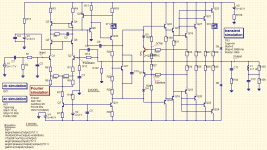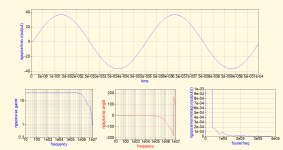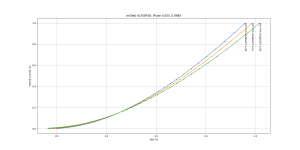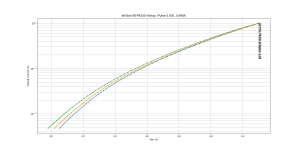Well almost, the MRF300 can go up to 250 MHz @ 300 W.
https://www.nxp.com/docs/en/data-sheet/MRF300AN.pdf
At $40 a piece or so, you won't probably be finding them in audio amplifiers soon.
When you take a look at the values for the matching network at 230MHz, you can see, that input and output are almost short circuits. By the way it is a lateral 😉
Slightly impractical package, but capable of high dissipation and the tempco has the friendly sign.
https://www.mouser.fr/datasheet/2/692/GS61008T_DS_Rev_200402-1837994.pdf

https://www.mouser.fr/datasheet/2/692/GS61008T_DS_Rev_200402-1837994.pdf

Plenty of Exicon Lateral MOSFETs are still listed as active at the Profusion website:
Lateral MOSFETs (Buy Online) | Profusion
Are they still manufactured at Semefab, or simply old dyes freshly packed (or labeled)?
So finally I have the choice between Lateral or more selfish a BJT design ;-)
Have you ever thought of a challenge of building a decent amplifier with ordinary parts like TIP41/42 or 2N5551/2N5401 or MPSA42/A92? I know these audio grade parts were created for a reason, but perhaps one could do reasonably well with common devices. Perhaps some cleverness with compensation can overcome some of the bandwidth limitations.
I have used the generic TIP41/42 and 2N5551/2N5401 and they seem to work fine. It seems that these might be available for awhile.
I have used the generic TIP41/42 and 2N5551/2N5401 and they seem to work fine. It seems that these might be available for awhile.
> its own feedback loop like QSC powerlite
This does not help with 2nd breakdown; the paper is 1998 and in those days they could still buy beefy-junction parts.
What helps with 2nd breakdown is the 4 step class H. VCE (VDS) never gets too high. You can turn most types of amplifier into a 4 step class H if you have enough taps on the power supply.
Output transistors never saturate if you use emitter followers. Seems to be commonplace to switch to common emitter output stages in many “pro” amps to get the cost down, but you certainly don’t have to build them that way. Getting a more or less conventional VAS to not stick to the rails isn’t all that hard either. There is more than one way to make a non-sticking amplifier.
Have you ever thought of a challenge of building a decent amplifier with ordinary parts like TIP41/42 or 2N5551/2N5401 or MPSA42/A92?
I built a REALLY nice amplifier using TIP41/2 and all generic house-numbered je-ne-sais-quoii TO-92’s for everything else. Back in my college days. Ran off a 25.2V/2A Radio Shack transformer and put out a whopping ten watts per channel.
I built a REALLY nice amplifier using TIP41/2 and all generic house-numbered je-ne-sais-quoii TO-92’s for everything else. Back in my college days. Ran off a 25.2V/2A Radio Shack transformer and put out a whopping ten watts per channel.
I think you can get some decent power and performance out of these simple parts. This is an output triple using four parallel TIP41/42 and a 2N5551/2N5401 VAS. The THD is 0.02% at 20 kHz. The output is 38 V peak into a 4 ohm load, or 180 W.
Given that 2N5551/2N5401 is about 2 cents a piece for Chinese versions, and TIP41/42 is about 35 to 50 cents a piece, this is not a bad solution I would think.
Attachments
Last edited:
My thought about vertical mosfets is that common source outputs have a significant advantage over simple source follower circuits as you are looking at about 8 V lower Vds at any time.
I use a combination of common source to the negative rail and common drain to the positive rail with bootstrapping for the common drain.
Email from Profusion:
Thanks for the heads up. I’ll dust off my DIY Audio login and see if I can produce an update to reassure people that our lateral mosfets aren’t going anywhere.
These two PMOS have a zero tempco point at an unexpectedly low current ; lateral ALFET for comparison.
If my measurement setup gives correct result, this would mean they should work fine in linear mode...
https://www.diyaudio.com/forums/sol...ed-transistor-measurements-2.html#post6706531
If my measurement setup gives correct result, this would mean they should work fine in linear mode...
https://www.diyaudio.com/forums/sol...ed-transistor-measurements-2.html#post6706531
Attachments
The IRP9610 looks much better than the IRFP9240 for an AB output.
The stable point is close to typical vertical output quiescent values.
Strange as it the lower voltage and higher current part
The stable point is close to typical vertical output quiescent values.
Strange as it the lower voltage and higher current part
Oops, only one of the graphs is in log scale.
Anyway, problem with IRF9610 is, it's a TO220 with a rather large 6.5°C/W RthJC so it's not suited for an output stage unless you use a huge quantity in parallel. But IRFP9240 tempco is pretty civilized too, just a few mV/°C, so I'm optimistic about this one.
Anyway, problem with IRF9610 is, it's a TO220 with a rather large 6.5°C/W RthJC so it's not suited for an output stage unless you use a huge quantity in parallel. But IRFP9240 tempco is pretty civilized too, just a few mV/°C, so I'm optimistic about this one.
Is PMOS just better by nature, for related reasons to them having higher Rds?
I don't see many smps with PMOS switchers
I don't see many smps with PMOS switchers
PMOS sucks on pretty much all metrics: higher capacitance, slower, more expensive, higher RdsON etc. NMOS are much better for switching, and in a switching converter, Vgsth tempco is irrelevant...
- Home
- Design & Build
- Parts
- Class AB "endangered"?




